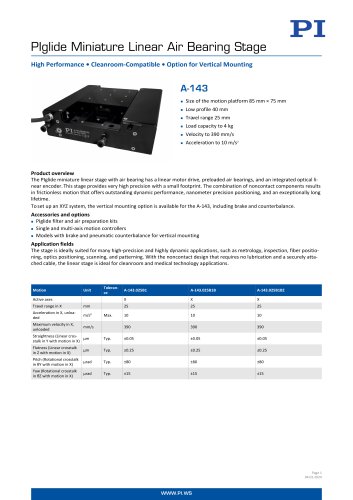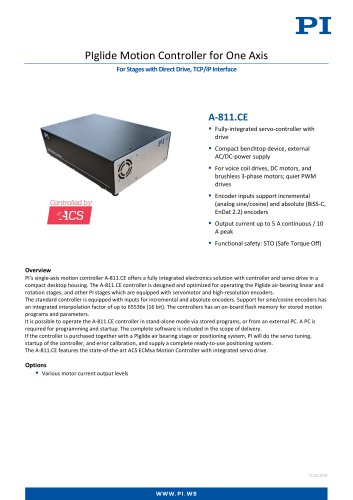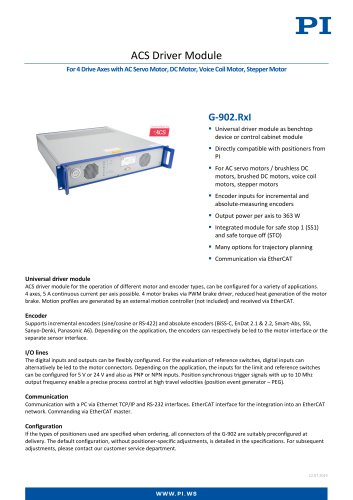
Catalog excerpts
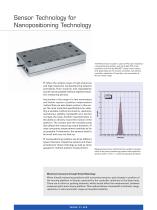
Sensor Technology for Nanopositioning Technology The PIOne linear encoder is used in PI's high-resolution nanopositioning system, such as N-664. This linear positioner is driven by NEXACT® piezo linear motors and, depending on the motion controller, can achieve a position resolution of less than one nanometer at 30 mm travel range PI offers the widest range of high-dynamics and high-resolution nanopositioning systems worldwide. Their linearity and repeatability would not be possible without highest-resolution measuring devices. Accuracies in the range of a few nanometers and below require a position measurement method that can also detect motion in this range. The most important specifications for selecting a suitable method are linearity, resolution (sensitivity), stability, bandwidth and, last but not least, the costs. Another important factor is the ability to directly record the motion of the platform. The contact with the movable parts also affects the measuring result; therefore, PI uses noncontact measurement methods as far as possible. Furthermore, the sensors need to be small and may not heat up. PI nanopositioning systems use three different types of sensors: Capacitive sensors and linear encoders for direct metrology as well as strain gauges for indirect position measurement. Measurements have confirmed the excellent repeatability of the piezo positioning system with capacitive sensors with 1.4 nm (1 σ value) of standard deviation Maximum Accuracy through Direct Metrology When directly measuring positions with noncontact sensors, each change in position of the moving platform is directly captured by the controller relatively to the base body. There are no drive or guiding elements, which would affect the measurement, between measured point and moving platform. This method allows a bandwidth in kilohertz range, resolution in sub-nanometer range and excellent stability.
Open the catalog to page 1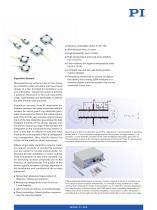
High temperature and long-term stability (<0.1 nm/3 h) Invar versions for highest temperature stability (5 × 10-6/K) Capacitive sensors from PI determine the distance between two plate electrodes without contact. An active guard ring electrode generates a homogenous field in the measurement area. This and the very precise parallel adjustment of the two electrodes guarantees the best possible linearity of the sensor signals over the entire measuring range. These sensors are integrated in the nanopositioning system in such a way that no effects on size and mass (inertia) are to be expected....
Open the catalog to page 2
PlOne Linear Encoders: Small with Picometer Resolution The capacitive measuring systems reach their limits with larger travel ranges: Either sensor areas become larger or resolution and linearity deteriorate. Nanopositioning system with piezomotors, which have travel ranges of several 10 millimeters, use linear encoders as position sensors. These are incremental measuring systems that consist of a scale and sensor head.The high-resolution linear sensor PIOne ensures a position resolution of far less than a nanometer with adequate processing of the measurement. The sensor head of the PIOne...
Open the catalog to page 3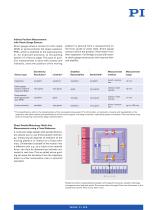
Indirect Position Measurement with Strain Gauge Sensors Strain gauge sensors consist of a thin metal (SGS) or semiconductor foil (piezo-resistant, PRS), which is attached to the piezoceramics or, for improved precision, to the guiding system of a flexure stage. This type of position measurement is done with contact and indirectly, since the position of the moving platform is derived from a measurement on the lever, guide or piezo stack. Strain gauge sensors derive the position information from their expansion. Full-bridge circuits with several strain gauge sensors per axis improve thermal...
Open the catalog to page 4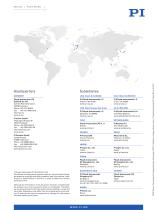
Headquarters GERMANY_ © Physik Instrumente (PI) GmbH & Co. KG All contents, including texts, graphics, data etc., as well as their layout, are subject to copyright and other protective laws. Any copying, modification or redistribution in whole or in parts is subject to a written permission of PI. Although the information in this document has been compiled with the greatest care, errors cannot be ruled out completely. Therefore, we cannot guarantee for the information being complete, correct and up to date. Illustrations may differ from the original and are not binding. PI reserves the right...
Open the catalog to page 5All Physik Instrumente catalogs and technical brochures
-
A-143
5 Pages
-
A-811.CE
3 Pages
-
G-902.RxI
5 Pages
-
P-405
4 Pages
-
PRYY
7 Pages
-
A-523
5 Pages
-
M-110 • M-111 • M-112 V6
4 Pages
-
L-812
18 Pages
-
RS-40 V7
4 Pages
-
A-68x
4 Pages
-
G-901
9 Pages
-
G-910.RC02
6 Pages
-
F-712.IRP
6 Pages
-
G-910.RC01 • RC03
4 Pages
-
C-663.12
3 Pages
-
C-887.53x
5 Pages
-
Piezoelectric Discs
7 Pages
-
L-402
5 Pages
-
P-840
4 Pages
-
M-238
5 Pages
-
L-220
5 Pages
-
P-725
9 Pages
-
C-413
3 Pages
-
P-518 • P-528 • P-558
6 Pages
-
PL112 – PL140
4 Pages
-
U-628
3 Pages
-
P-545.3D8S
5 Pages
-
P-611.XZ • P-611.2
4 Pages
-
P-541.2 • P-542.2
5 Pages
-
Leading in Precision Positioning
12 Pages
-
Engineered Systems
8 Pages
-
Precision Motion Control
4 Pages
-
Drivetrain Elements
4 Pages
-
Motors and Drives
3 Pages
-
Positioning with Piezo Systems
248 Pages
-
Hexapod Positioning Systems
133 Pages
-
PIRest Actuators - P-131
4 Pages
-
High-Load Linear Stage - L-417
12 Pages
-
PICA piezo amplifier module
3 Pages
-
V-412 • V-418 • V-423
2 Pages
-
S-335 Fast Tip/Tilt Platform
3 Pages
-
Q-Motion® SpaceFAB
4 Pages
-
A-131
5 Pages
-
d-891
1 Pages
-
PI Datasheet V-275
5 Pages
-
PI Datasheet V-273
5 Pages
-
PI Datasheet VT-80
3 Pages
-
A-65x
4 Pages
-
A-60x.MTT
1 Pages
-
A-80x
3 Pages
-
A-322
3 Pages
-
A-110
3 Pages
-
A-141
3 Pages
-
A-123
5 Pages
-
A-121
5 Pages
-
DT-34
4 Pages
-
D-015 • D-050 • D-100
5 Pages
-
A-10x
3 Pages
-
New Products 2015
48 Pages
-
PI Products for Microscopy
36 Pages
-
PI Electron Microscopy
16 Pages
-
Piezo Motors and Stages
48 Pages
-
Piezo Mike Linear Actuators
16 Pages
-
PI Product Overview
34 Pages
-
PILine® Ultrasonic Piezomotors
20 Pages
-
Piezoelectric Actuators
74 Pages
-
Hexapods 6-Axis Stages
56 Pages
-
Piezo Amplifiers & Controllers
44 Pages


